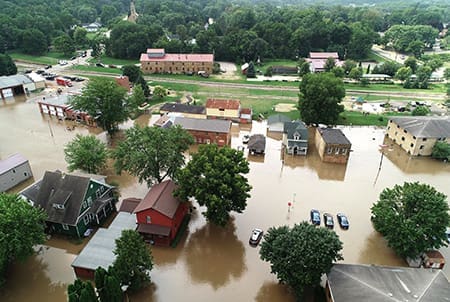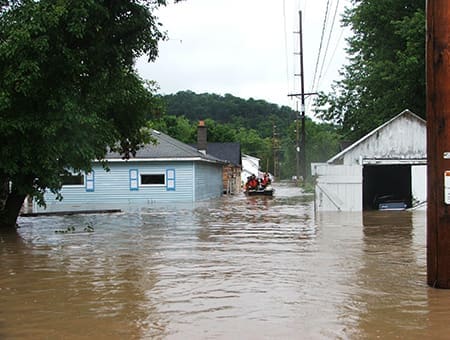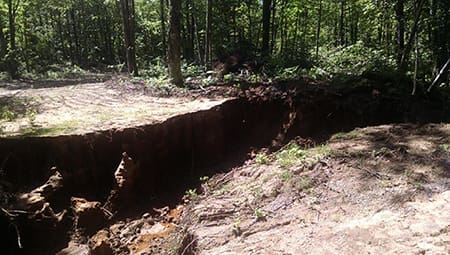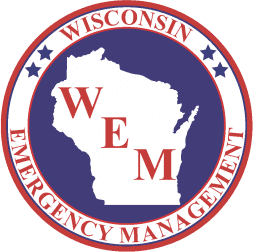
MADISON, Wis. – Natural disasters are growing in strength and frequency, with millions of dollars spent each year on disaster response and recovery. Wisconsin helps communities find ways to lessen the impact of disasters to protect lives and improve safety.
The state of Wisconsin Hazard Mitigation Plan was recently updated and is the overarching document outlining the ways Wisconsin Emergency Management (WEM) and other state agencies help communities become more resilient.
“Mitigation saves lives and keeps our homes, businesses, and communities safe,” said WEM Acting Administrator Greg Engle. “This plan demonstrates the state’s commitment to reduce risks and guide decisions on distributing resources to reduce the effects of hazards.”
The plan looks at potentially disastrous events communities may face, identifies vulnerabilities, and proposes actions to reduce risks. It includes a mitigation framework that identifies goals and recommended actions that would reduce or prevent injury or damage from hazards.
The plan is required by the Federal Emergency Management Agency (FEMA) when states, local, and tribal governments applying for certain types of non-emergency disaster assistance. Wisconsin is one of fifteen states that have an enhanced state mitigation plan, which can make additional federal funding available. WEM helps communities secure federal funds from the Building Resilient Infrastructure and Communities (BRIC) Program and the Hazard Mitigation Grant Program (HMGP).
With every dollar spent on mitigation efforts, communities save four dollars in future disaster response and recovery, according to the National Institute of Building Sciences. The amount saved to reduce flooding is higher, potentially saving seven dollars in future costs for each dollar spent on mitigation efforts.
Since 1980, Wisconsin has incurred up to $20 billion in disaster-related damages. Flooding, drought, and severe storms make up over 98 percent of these costs.
The number one risk in Wisconsin is flooding. A Presidential Disaster Declaration for flooding has been declared for 70 of Wisconsin’s 72 counties since 1991.
In recent years, flood-related damage has increased. Robyn Fennig, WEM’s Mitigation Supervisor says it is due to increasing demand for waterfront housing, land use changes, altering streams, and increasing precipitation amounts.
“Flooding is Wisconsin’s most costly natural disaster,” said Fennig. “Reducing flooding risk is possible. Local and tribal governments should be proactive to reducing flooding potential. This includes applying for grants to mitigate potential losses and increase resiliency.”

A mitigation success story can be found in Gays Mills. Although it is in one of the most scenic areas in the state, the village was prone to flooding in the Kickapoo River watershed. With the help of a series of grants, the village and Crawford County Emergency Management were able to acquire flood-damaged properties and convert them into open spaces. The village eventually partially relocated to higher ground
Mitigation projects in Gays Mills from 2007 through 2018 totaled an estimated 277-percent return on investment through property acquisition, saving federal, state, and local agencies nearly $6 million dollars.
“The mitigation efforts in Gays Mills were enormously beneficial and prevented millions of dollars in losses,” said Fennig. “The more examples that we show for investing in mitigation, it makes it more accessible to other communities in the state.”
As Wisconsin continues to grow warmer and wetter, increased flooding is likely, according to Fennig.
Although climate change was mentioned in the previous plan, a new section was added to the Threat and Hazard Identification and Risk Assessment (THIRA) Appendix. It delves deeper into national and statewide climate change projections and potential mitigation efforts. Climate change is an increasing concern for communities across the state. As of 2021, WEM Mitigation staff reviewed more than 80 approved local and tribal plans. Nearly 64 percent of those plans mentions the impact of climate change.

There is also an emerging trend in mitigation efforts in the state, communities looking at rebuilding natural infrastructure as they repair flood-related damage. An example of this is a study currently underway in Ashland County. After losing wetlands and floodplain storage over the past 150 years from land use changes, the county has been experiencing repetitive flooding for decades.
“This is the first project in the state to see how nature-based solutions can reduce catastrophic impacts in degraded watersheds,” said Fennig. “Studying how wetland and stream restoration can break the cycle of repetitive damages will not only find a way to reduce flooding impacts, but also enhance waterways that provide many benefits to Wisconsin.”
The study, which Fennig recommended to receive FEMA funding, is expected to run through 2023. Managed by Ashland County Emergency Management and the Wisconsin Wetlands Association, the study is expected to provide access to better data for natural flood defenses and mitigation practices to build flood resilient communities. There is also a potential for these mitigation efforts to be used in other flood-prone communities.
Mitigation efforts are not reserved for government agencies, and people can invest in actions to reduce risks in their homes.
“There’s a lot of things people can do that will be a huge return investment outside of grant assistance” said Fennig. “Effective mitigation isn’t always big or expensive and allows you to return home more quickly after a disaster.”
Fennig suggested elevating utilities to keep them out of floodwaters or preventing sewage backup by contacting a local plumber to install protective equipment as simple steps property owners can take. Mitigation efforts can also be taken outside of a home, such as directing water away from buildings to reduce the risk of flooding and removing debris from yards to reduce wildfire risks.
To learn more about mitigation resources for property and homeowners head to : https://www.fema.gov/grants/mitigation/hazard-mitigation/property-owners.

